
Learning About Sustainable Management of National Parks and Agent–Based Models
By Melody Zarria
Melody Zarria, a research assistant visiting from the Universidad Nacional Agraria La Molina (UNALM) – came to Colorado State University (CSU) in Summer 2015, to work on modeling cattle grazing in the high Andean wetlands of Peru as part of a long-term collaborative project between CSU and UNALM. She discusses her lessons learned working with Drs. Randy Boone and Gillian Bowser on Agent Based Modeling (ABM).
I studied Animal Science at Universidad Nacional Agraria La Molina (UNALM), Lima – Peru. I’ve always been interested in extensive livestock production in part because many poor rural families depend on cattle which graze on rangelands as their main source of food; however, most of rangelands show significant signs of degradation. This situation prompted me to pursue a master program in Animal Production specializing in Rangeland Ecology and Management.
Now, I work as research assistant at Rangeland Ecology and Utilization Laboratory (LEUP) and as project coordinator at the Environmental Management Office at UNALM.
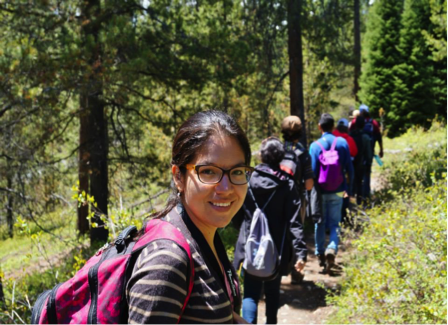
My research interests focus on designing and evaluating range improvement practices (grazing systems and re-vegetation programs), using Geographic Information Systems and Remote Sensing to map and analyze vegetation, and developing sustainable rangeland management plans.
In 2013, the LEUP and the Natural Resource Ecology Lab (NREL) began collaboration. Dr. Javier Ñaupari, researcher at LEUP, did an internship at NREL under the tutelage of Dr. Randy Boone to learn about Agent-Based Models (ABM) as part of the research study “Puna Herders: Vulnerability and Adaptation to Climate Change” sponsored by the Fulbright Nexus Scholar Program. It was then that Dr. Ñaupari met Drs. Gillian Bowser and Dave Swift who were conducting research in Peru.
In 2014, as part of the established links between both institutions, Dr. Ñaupari invited Dr. Bowser to apply the Fulbright Nexus Scholar Program to research high Andean wetlands in Huascarán National Park (HNP) (Peru – Ancash). By pure coincidence, I was working on another project at HNP at about the same time that Dr. Bowser and grad student Kate Wilkins came to Huaraz. So we began working together and evaluating the same research areas, which allowed us to exchange experiences.
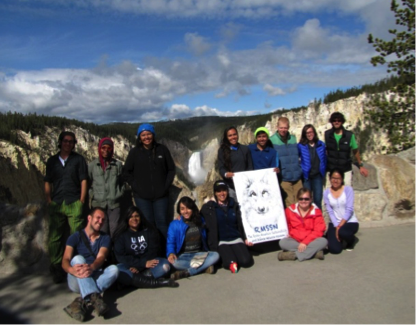
Last year I spent about two months in Colorado. The first two weeks I joined the Rocky Mountain Sustainability and Science Network (RMSSN), led by Dr. Gillian Bowser. The student group was composed of a multidisciplinary team of undergraduate and graduate students of different American and foreign universities, including Mexico and The Netherlands.
Part of the group activities consisted of learning and sharing experiences about management of natural areas among students, researchers and rangers. We visited the national parks: the Grand Teton, Rocky Mountain and Yellowstone. We carried out field evaluations, hiking, as well as group discussions to identify actions to improve the sustainable management of the parks. This experience allowed me to learn about the management situation of natural areas in the US in comparison Peru’s.
From the third week of my stay, I went to CSU- NREL to learn about Agent-Based Models (ABM) with Professor Randy Boone. Dr. Boone taught me ABM theory, its basis, approaches and applications. ABMs create, simulate and analyze actions performed by agents or individuals according to their needs and limitations.
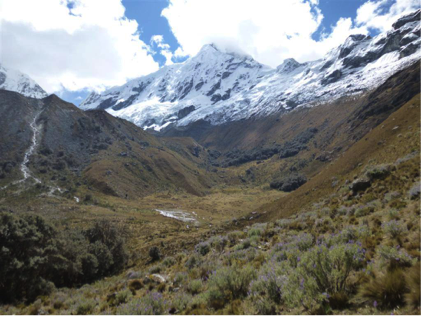
The practical part involved using the simulation software NetLogo to get familiar with tools and programming commands, and to explore models. The next activities consisted on applying what I learnt and create an ABM. The ABM’s purpose was to analyze the effects of landscape heterogeneity (vegetation type, topography and water availability) on the movement of cattle in Quebrada Ulta located at Huascaran National Park (HNP).
The main components that we added to our ABM included:
- Aerial biomass production, related to vegetation types: bofedales (highland Andean wetlands), short grasses prairie, shrubland, and tall grasses prairie;
- Topographic features: slope % (0-10, 10- 25, 25-60, >60) and elevation (m.a.s.l);
- Livestock type with creole cows adapted to mountain conditions, grouping in herds of 30; and
- Water availability and accessibility e.g. rivers, streams, and permanent bofedales.
The ABM also included body condition which was determined through grass biomass production and daily nutritional needs. The model incorporated the population factors through estimations of death and birth rate, which depends on body condition (good and poor) and includes a random factor (e.g. unfavorable weather condition, diseases, and accidents).
The model consisted of two sceneries: hypothetical and real. For the hypothetical scenario, the mountains, slopes and vegetation were created randomly. Mountains were created by establishing a random interval of elevation (25%), and considering 20,000 feet as the highest value, land slopes were created considering the elevation and size of each patch. Location of tall and short grasses prairie, and shrubland was created randomly but the vegetation cover of each type could be modified. Meanwhile bofedales were established as permanent or temporary and were located at slope values ranging from 5 -10 %.
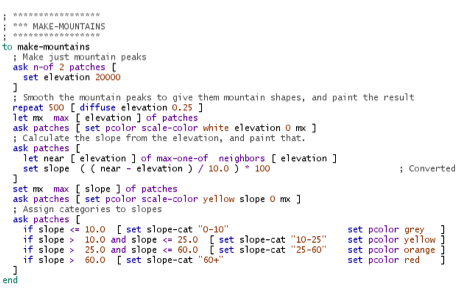
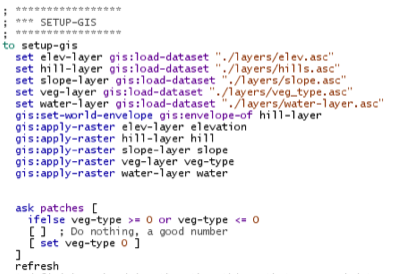
For the real scenario elevation, slope, and topography data was obtained from a DEM file (Raster). Information of vegetation types and water sources obtained from field assessments was converted from a vector to a raster file. Then, data was converted to ASCII code to be used in NetLogo.
Due to the lack of information of aerial biomass production of Andean rangelands and because it was a practice ABM, it was necessary to use Fryxell 1 equation to estimate aerial biomass production (savanna ecosystems) based on growing days and annual rainfall.
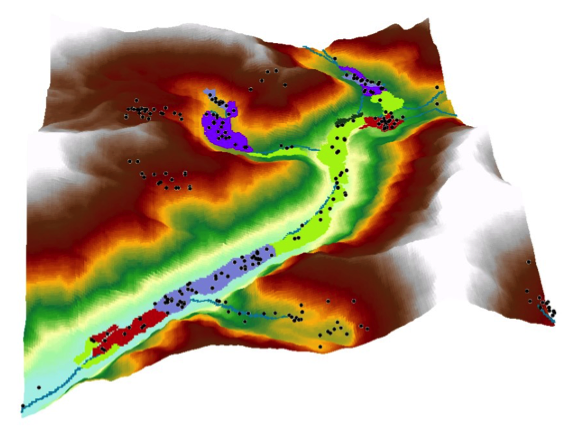
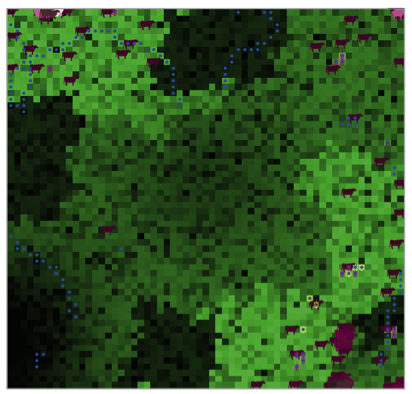
The pattern of cattle movement for both scenarios was established using a temporary score of aerial biomass, slope and distance to water sources. Also, includes strength factors (topographic and water needs).
The creation and analysis of the ABM allows researchers:
- To design research studies to gather required information for the model such as biomass production, energy needs of animals (grazing, finding water sources, etc.) and to identify the most relevant variables of the model.
- To identify emergence patterns related to animal behavior at the micro-level and interaction of herds at the macro-level. For us, the model showed some cattle staying near bofedales despite the availability of other vegetation type.
- To analyze the effect of different variables such as the effect of mean annual rainfall and its variability on biomass production, availability of water sources and movement of livestock as well as the effect of animal behavior and its impact on the ecosystem.
- To incorporate information generated by the ABM (NetLogo) such as coordinates of animals location into a GIS software to identify and analyze the movement pattern of animal. Also, it would help to improve the presentation of results (maps) and facilitate the understanding of the model.
To sum up, my internship at NREL – CSU was a rewarding experience. I learned about management practices for natural areas, share experiences with other researchers, and visit many beautiful places. I found ABM to be useful tools that provide important insight on the effects of current management on ecosystems. ABM can also be used to propose natural resources and livestock management strategies to local communities for their sustainable management.
Finally, I want to thank Dr. Bowser for the opportunity intern at NREL and be part of RMSSN. I would also like to thank Dr. Boone for teaching me about ABM and for his constant patience and willingness to help when I had questions.
For more information on Rangeland Ecology and Utilization Laboratory check out their website at: http://www.lamolina.edu.pe/FACULTAD/Zootecnia/Leup/proyectos.htm
If you like flowers and are planning to visit Huascarán National Park (Peru), you can check this field guide: http://fieldguides.fieldmuseum.org/sites/default/files/rapid-color-guides-pdfs/750_peru_plants_of_the_cordillera_blanca.pdf
Connect with EcoPress on social media! Like us on Facebook and follow us on Twitter, @nrel_science, for more stories and news.